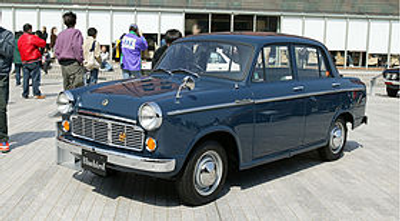The Evolution of the Nissan Bluebird 312 (Facelift 1960)
Introduction
The Nissan Bluebird 312, with its facelift in 1960, is a noteworthy addition to the prestigious Bluebird lineup. This car model generation was a significant step forward for Nissan, with improvements in design, performance, and technology. Let's explore the key features and advancements that made the Nissan Bluebird 312 (facelift 1960) a popular choice among car enthusiasts during its era.
Refreshed Design
The facelifted Nissan Bluebird 312 boasted a more stylish and streamlined design compared to its predecessors. The car featured a sleeker and more aerodynamic body shape, contributing to improved fuel efficiency. The front grille was refined, giving the Bluebird a more modern and sophisticated look. Additionally, the facelifted version incorporated new chrome accents and redesigned headlights, further enhancing its visual appeal.
Enhanced Performance
Under the hood, the Nissan Bluebird 312 (facelift 1960) offered an upgraded engine that delivered superior performance. The car was powered by a four-cylinder engine that produced increased horsepower and torque compared to previous models. This enhancement significantly improved the Bluebird's acceleration and overall driving experience. The transmission system was also optimized, providing smoother gear shifts and better control.
Technological Advancements
The facelifted Nissan Bluebird 312 introduced some significant technological advancements for its time. It featured an improved electrical system, including a more reliable and efficient charging system. Additionally, the car came equipped with a more advanced suspension system, offering enhanced stability and a smoother ride. These technological upgrades improved not only the comfort level but also the overall safety of the vehicle.
Interior Comfort and Features
The Nissan Bluebird 312 (facelift 1960) prioritized driver and passenger comfort with its redesigned interior. The seats were made more comfortable and supportive, ensuring a pleasant driving experience for long journeys. The dashboard was revamped, featuring a more modern layout, and the controls were ergonomically positioned for easy access. Moreover, the facelifted Bluebird provided ample legroom and cargo space, making it suitable for families and individuals alike.
Safety Enhancements
In terms of safety, the Nissan Bluebird 312 (facelift 1960) offered several notable improvements. The car was equipped with enhanced braking systems, ensuring shorter stopping distances and increased control during emergency situations. It also featured improved visibility, thanks to larger rearview mirrors and better-angled windshield wipers. These safety enhancements added an extra layer of protection for the driver and passengers.
Popularity and Legacy
The Nissan Bluebird 312 (facelift 1960) gained popularity among car enthusiasts for its blend of style, performance, and reliability. Its unique design and technological advancements made it stand out in the market. The facelifted Bluebird was highly regarded for its durability, reflecting Nissan's commitment to producing long-lasting and dependable vehicles. Even today, the Bluebird 312 remains a classic symbol of automotive excellence and continues to have a loyal following among car collectors worldwide.
Conclusion
The Nissan Bluebird 312 (facelift 1960) represents a significant milestone in the evolution of the Bluebird lineup. It showcased improved design, performance, and technology, setting a new standard for its time. With its sleek exterior, enhanced engine, and advanced features, the facelifted Bluebird offered a compelling driving experience. Its popularity and lasting legacy speak volumes about its impact on the automotive industry. The Nissan Bluebird 312 (facelift 1960) will always hold a special place in the hearts of car enthusiasts and remains a testament to Nissan's commitment to innovation and excellence.

